
|
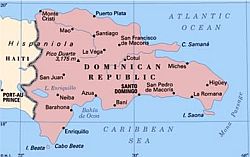
Figure 1: Rancho Viejo is a small community in the Dominican
Republic located south west of San Juan, near Haiti.
|
CE
4905
2003 International
Senior Design in the Dominican Republic
See the Slide
Show of Photos
|
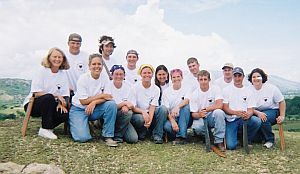
Front Row, left to right, Linda Phillips, Kerry Price, Annette
Dickinson, Shauna Ross, Mollie Kauza, Ray Trudgeon, Jesse Mowrer, Angie
Martello Back Row, left to right, Andy Luehmann, Tim Martin, Matt Niskanen,
Rachel Parini, Brent Rathka, Kevin Pittelko
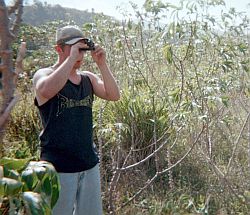
Figure 4: Ray using Abney level
|
|
Introduction
Twelve Michigan Tech students
along with Linda Philips, instructor, and Matthew Niskanen, Master's International
graduate of MTU, traveled to the Dominican Republic for senior design
in May of 2003. The students paid tuition, for supplies to construct
a water storage tank, and some other
costs.
The main objective was to create
an aqueduct that would supply water to the people of a village called
Rancho Viejo. The water is not treated, and the aqueduct simply
moves the water closer to the people. Ten days were spent aiding
in the construction of the water storage tank, surveying
pipelines, and collecting information for the future design.
While on site students learned
the local building techniques. This knowledge insured that design elements
would be feasible. Working with the Dominicans also provided a unique
forum to discover and appreciate cultural differences.
|
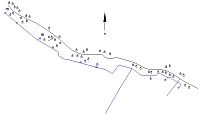
Figure 2: Map of Rancho
Viejo and proposed pipelines |
|
Village
Census
To determine the total water demand of Rancho Viejo a census was conducted.
This census found that the community consisted of 52 households totaling
275 people. The homes are grouped in small clusters spread out along the
road. Using a value of 10 gallons per person per day provided by Peace
Corps of the Dominican Republic a total demand of 2750 gallons per day
was found for the system.
|
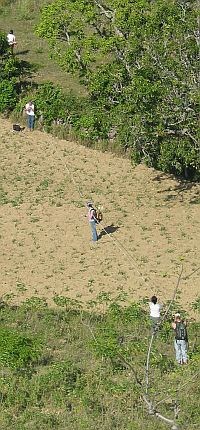
Figure 3: Survey team
crossing field |
|
Survey
and Route Selection
The purpose of the
land survey was to gather data for the design of the water system. This
formed the basis of the system design, pipe sizes, water tank placement,
as well as identifying the need for stronger pipe sections used in gorge
crossings and sections of high pressure. Due to a lack of technology and
availability of modern surveying equipment, Abney Hand Levels were used.
Three groups were formed, consisting of three to four people and each
took a route to survey from the water tank. The three routes were: the
spring to the water tank, the water tank to the east, and the water tank
to the west.
Once the routes were
identified, each group took a stack of hand made stakes, a can of spray
paint and began the survey. The information recorded in a field notebook
included the angles, distances, and compass bearings of the surveyed points.
The main criteria
for route selection included avoiding hard rocky terrain that would impede
installation, and avoiding areas where erosion could easily expose the
pipeline. To meet these criteria routes through fields were often chosen.
|

Figure 5: Spring location
|
|
Water
Collection
The spring location (Figure 5) in the base of a ravine presented many
problems, such as the close proximity of two streams, that needed to be
addressed in the design process. The water collection basin shown in Figure
6 was designed based on suggestions from former Peace Corps Volunteers
and information found in A Handbook to Gravity Fed Water Systems by Thomas
Hardy. The collection basin has three primary features. First, a reinforced
concrete block wall encompasses the spring acting as a levee to prevent
stream water from contaminating the system. Second, filter cloth and rock
are used to prevent sediment migration into the system. Sediment would
cause damage to the pump and clog pipes. Finally, an impermeable membrane
is used to prevent runoff from the fields above from entering the system.
|
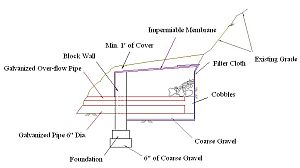
Figure
6: Cross section of Spring Basin
|
|
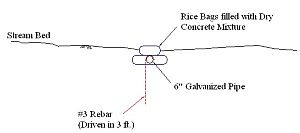
Figure 7: Stream Crossing |
|
|
Stream Crossing
After leaving the collection
basin the water must cross the stream to the pump house. A 6” galvanized
pipe will be used for the crossing. #3 rebar will be driven into the streambed
and tied to the pipe to secure it in place. Finally rice sacks filled
with concrete will be placed over the pipe to prevent damage from debris
during flooding. This is shown in Figure 7. |
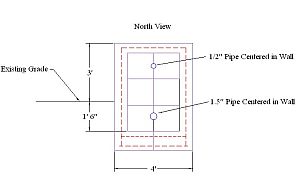
Figure 8: Pump House
Cross Section |
|
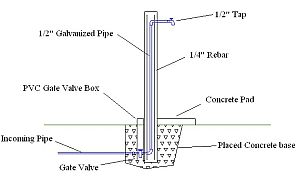
Figure 9: Llave design
|
Pump House
The pump house is a reinforced concrete block building with cast in place
floor and roof (Figure 8). The pump house was located on the village side
of the streams to further protect the pump. If the pump were located directly
at the spring as originally planned the power supply and pipe connected
to the pump would have to cross the stream. If these were wiped out in a
flood, sever damage to the pump could occur. The costs of such damage would
make repair of the system infeasible.
|
|
Llaves
The llaves act as the water faucets for the system. They must be easy to
construct, easy to maintain, and have adequate strength and durability.
It was determined that a wooden llave would not have sufficient strength
and durability, and a stone llave would be difficult to construct due to
the Dominicans unfamiliarity with this type of construction. The chosen
design (Figure 9) was a precast, reinforced concrete llave that will stand
three feet off of the ground. It will be able to be easily constructed and
maintained, and also have the strength and durability needed. This llave
is also similar to others found in the area, so there is also familiarity
with the design
|
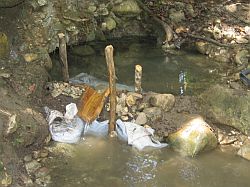
Figure 10: Spring Pool
Dam
EPANET
Our system was modeled in a
computer program called EPANET. This system allowed us to easily determine
the pipe sizes, and pressure at various points along the route. The pipe
type was predetermined during the survey; PVC pipe and galvanized iron
pipe were the two types of pipe used. EPANET showed us that the llaves
along the east side of the tank had low pressure. An alternate route was
developed for the east side of the tank that combined the first two llaves,
and left the last llave as it was. |
|
Pump Selection
The first step in pump selection was to determine the pump requirements.
From the survey it was found that the tank was approximately 150 feet above
the spring. To determine the spring flow rate a dam was built around the
spring (Figure 10) and the volume time method was used. This process determined
the rate to be 6 gal/min. At this rate the spring will supply approximately
1.6 times the demand in 12 hours of pumping.
The second step was to choose a power supply. Use of the power grid was
dismissed due to the systems unreliability. Many times while in the Dominican
Republic the power would go off for no apparent reason, sometimes over a
day. The inconsistent and irregular winds in the area eliminated the use
of a wind turbine. Due to the location near the equator and consistent 12
hours of daylight year round, solar power was chosen for the system.
With the help of Oasis Montana Inc., Grundos 11 SQF-2 submersible helical
rotor pump was chosen (Figure 11). This pump is specifically designed for
use with solar power and has a high resistance to particles in the water.
|
 |
Cost/Schedule
Analysis
Total construction is being broken into two separate phases, a trip in
December and a separate section to be completed by the new Peace Corps
Volunteer. The trip in December intends to install everything necessary
to move water from the spring to the storage tank. This construction will
take seven days and cost $8423. The remaining construction will be the
installation of the tap stands and distribution pipeline. The installation
of the east pipeline will take five days and cost $725. The installation
of the west pipeline will take 16 days and cost $1670. The construction
and installation of the nine llaves will take 19 days and cost $245. A
total of 49 days has been scheduled for completion. There has been an
additional $200 added in the total for incidental costs, this brings the
project’s total cost estimated to $11,263
Spring Entrapment Basin
$950
Pump House $550
Pump $6,300
Piping and Fittings $3,100
Llaves $250
Incidental Costs $200
Total $11,350
|
| Summary
and Conclusion
The
final design of the water system for the village of Rancho Viejo is a
pump assisted gravity system. The spring will be tapped using the
previously discussed spring entrapment basin. This basin harnesses
the water and feeds the SQF-2 submersible helical rotor pump.
The pump pushes water up a one and a half-inch diameter pipe line at approximately
six and a half gallons per minute. This flow will be sufficient
to fill the pre-constructed storage tank. From the tank, water enters
eastern and western distribution branches. The pipes in these branches
range from one and a half inches to a half-inch. The branches are
gravity fed from the tank to supply the 9 llaves located throughout the
village.
The installation of
the pump and the pipe line to the tank will take place in December of
2003. This section of the project will take a total of seven-days
and cost approximately $8,500. The remainder of the project will
be left to be completed after the planned arrival of a new Peace Corps
Volunteer. This portion of the project will cost approximately $2,700
and required 42-days for completion. The final construction of this
project will have brought water to a community of approximately 275-people
many of whom have to currently walk in excess of a mile to obtain their
water. In addition, this project has not only taught a group of
college students how to apply their knowledge of engineering to the design
of a water system, but also how their work can dramatically affect the
lives of others.
|
See the Slide
Show of Photos
|
| |
Michigan Technological
University
Department of Civil and Environmental Engineering
1400 Townsend Drive
Houghton, Michigan, 49931 - 1295, USA
Department Phone: 1-906-487-2520
Department Fax: 1-906-487-2943
Department E-mail: cee@mtu.edu
© 2004 Michigan Technological University
The sale or commercial use of Illustrations, photographs and graphic images
presented on this site is not permitted. Educational uses are permitted,
provided credit is given to sources.
|
|












